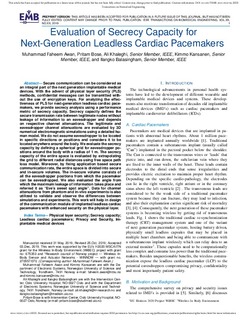Evaluation of Secrecy Capacity for Next-Generation Leadless Cardiac Pacemaker
Journal article, Peer reviewed
Accepted version

Åpne
Permanent lenke
http://hdl.handle.net/11250/2635914Utgivelsesdato
2019Metadata
Vis full innførselSamlinger
Originalversjon
10.1109/TBME.2019.2958748Sammendrag
Secure communication can be considered as an integral part of the next generation implantable medical devices. With the advent of physical layer security (PLS) methods, confidential messages can be transmitted without the use of encryption keys. For analyzing the effectiveness of PLS for next-generation leadless cardiac pacemakers, we provide secrecy analysis using a performance metric of secrecy capacity. Secrecy capacity defines the secure transmission rate between legitimate nodes without leakage of information to an eavesdropper and depends on respective channel attenuations. The legitimate and eavesdropper channel attenuations are evaluated by 3D numerical electromagnetic simulations using a detailed human model. We do not assume eavesdropper to be located in specific directions or positions and considers it to be located anywhere around the body. We evaluate the secrecy capacity by defining a spherical grid for eavesdropper positions around the body with a radius of 1 m. The secrecy capacity of the entire space is evaluated by extrapolating the grid to different radial distances using free space path loss model. Moreover, by fixing application based secure communication rate, the entire space is divided into secure and in-secure volumes. The in-secure volume consists of all the eavesdropper positions from which the pacemaker can be eavesdropped. We also evaluated the angle from which the maximum leakage of information takes place and referred it as “Eve’s sweet spot angle”. Data for channel attenuations from phantom and in-vivo experiments is also utilized to validate and observe the differences between simulations and experiments. This work will help in design of the communication module of implanted leadless cardiac pacemakers with enhanced security on the physical layer.